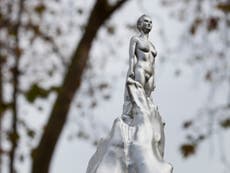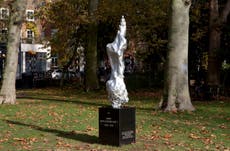A vindication of the right to see women naked: the statue for Mary Wollstonecraft has set us back centuries
Maggi Hambling’s controversial artwork diminishes Wollstonecraft’s ground-breaking achievements – nice abs, though


Your support helps us to tell the story
From reproductive rights to climate change to Big Tech, The Independent is on the ground when the story is developing. Whether it's investigating the financials of Elon Musk's pro-Trump PAC or producing our latest documentary, 'The A Word', which shines a light on the American women fighting for reproductive rights, we know how important it is to parse out the facts from the messaging.
At such a critical moment in US history, we need reporters on the ground. Your donation allows us to keep sending journalists to speak to both sides of the story.
The Independent is trusted by Americans across the entire political spectrum. And unlike many other quality news outlets, we choose not to lock Americans out of our reporting and analysis with paywalls. We believe quality journalism should be available to everyone, paid for by those who can afford it.
Your support makes all the difference.Tough year to be a statue. Granted, it’s been a tough year for most of us, but statues, already susceptible to pigeon defecation and wind chill, have borne the brunt of our 2020 ire. And now, no sooner has a new statue been erected, than we are tearing it down – figuratively, at least.
The 18th century feminist thinker Mary Wollstonecraft has been commemorated, after a decade-long campaign, with a sculpture on Newington Green in north London, where she opened a girl’s school 200 odd years ago.
The statue, created by the artist Maggi Hambling, is cast in silvered bronze and depicts an unidentifiable mass of female bodies, a molten wave from which a lone figure emerges. The bodies, Hambling says, “rise together as if one, culminating in the figure of a woman standing free”. And she is indeed free – free from clothes, that is. The woman is stark naked.
A sculpture for Mary Wollstonecraft was intended to challenge the traditional statue format by “elevating an idea, personifying the spirit, rather than depicting the individual”. Finally, after two centuries, a statue of Wollstonecraft stands among London’s men. But it doesn’t depict Wollstonecraft at all.
Naturally, people are not thrilled by this. Why must this woman be forced to represent all women when countless men from history have been honoured on their own terms? In a city in which 90 per cent of monuments celebrate the achievements of men, is this supposed to be a one-size-fits-all solution? The diminutive dimensions of the female figure only serve to rub salt into this particular wound.
Wollstonecraft was a radical intellectual who challenged traditional patriarchal structures and the subservient role of women in society. Her seminal feminist text, A Vindication of the Rights of Woman (1792), was so revolutionary in its thinking that numerous attempts were made to discredit the author, and her name was wiped from the history books.
People are baffled as to why the mother of feminism, whose words would go on to inspire the fight for women’s enfranchisement some 100 years later, has been commemorated with a naked woman, especially when the woman it is designed to honour wrote so passionately about how female objectification belittled women, making them “literally speaking, slaves to their bodies”, and how “men endeavour to sink us lower, merely to render us alluring objects for a moment”.
To add insult to injury, the woman in the statue embodies all the damaging beauty standards that have been thrust upon us for millennia. More than just naked, the statue appears to have a personal trainer or at least to have purchased a Peloton bike during lockdown. She has abs, not of bronze, but steel, perfectly toned and with a miraculously perfect thigh gap to boot. Her breasts are so sculpted, I can only imagine the best plastic surgeon on the West Coast has designed them. Is this what “everywoman” is supposed to look like? I certainly don’t. Thankfully, to assure us that this woman is a real feminist, she has a bush that would put any Women’s Libber to shame.
I suppose it’s a development from the Medusa statue in New York, who seemed to have paid a visit to her local wax salon – “one Hollywood for the road, please, Aphrodite!!” – before lopping off Perseus’ head. Luciano Garbati’s Medusa with the Head of Perseus (2008) – a riff on Benvenuto Cellini’s Perseus With the Head of Medusa – was last month placed opposite the court in Manhattan where the sex offendor Harvey Weinstein stood trial, in honour of the #MeToo movement.
Garbarti’s rather literal inversion of the Greek myth, intended to give Medusa back her power in a rejection of a misogynistic tale of rape and injustice, instead serves only to place a seven-foot naked woman opposite a courthouse in which women fought against unwanted sexual attention. Medusa, once turning men to stone with her gaze, has now literally been turned to stone for men to gaze upon.
And now Hambling has turned one of the foremost intellectuals of the 18th century into Page Three fodder. It’s difficult to imagine, as Twitter users joked, Churchill honoured via a statue with his balls out on Whitehall or Dickens or Einstein mooning passers-by from plinths. Difficult – because it would never happen.
This is not to say naked women always pose a feminist conundrum, but while Hambling said she wanted the sculpture to reflect Wollstonecraft’s spirit and to move away from the tradition of “male heroic statuary”, she has instead embraced a traditional patriarchal way of observing the female form, leaning directly into a centuries-long Western art historical tradition of female objectification.
In his 1972 book Ways of Seeing, the art critic John Berger wrote of how in art, “women are depicted in quite a different way from men – not because the feminine is different from the masculine – but because the ‘ideal’ spectator is always assumed to be male”. Throughout the Renaissance, women were excluded from life drawing classes, unable to learn how to accurately depict the nude female form. As a result, woman, as the feminist art historian Griselda Pollock wrote in 1988, “is thus represented as object for art rather than producer of it”.
Wollstonecraft is not the protagonist here; the spectator is – and the feminist remains faceless among London’s statues, her ground-breaking achievements diminished. It’s less a vindication of the rights of woman, more a vindication of the right to see woman naked.
Hambling said earlier this year that she hopes the statue will “act as a metaphor for the challenges women continue to face as we confront the world”. She’s certainly achieved that aim – the statue does act as a metaphor for how women continue to be portrayed. Reduced to their sum parts, placing them right back in the position from which Wollstonecraft sought to liberate them.





Join our commenting forum
Join thought-provoking conversations, follow other Independent readers and see their replies
Comments